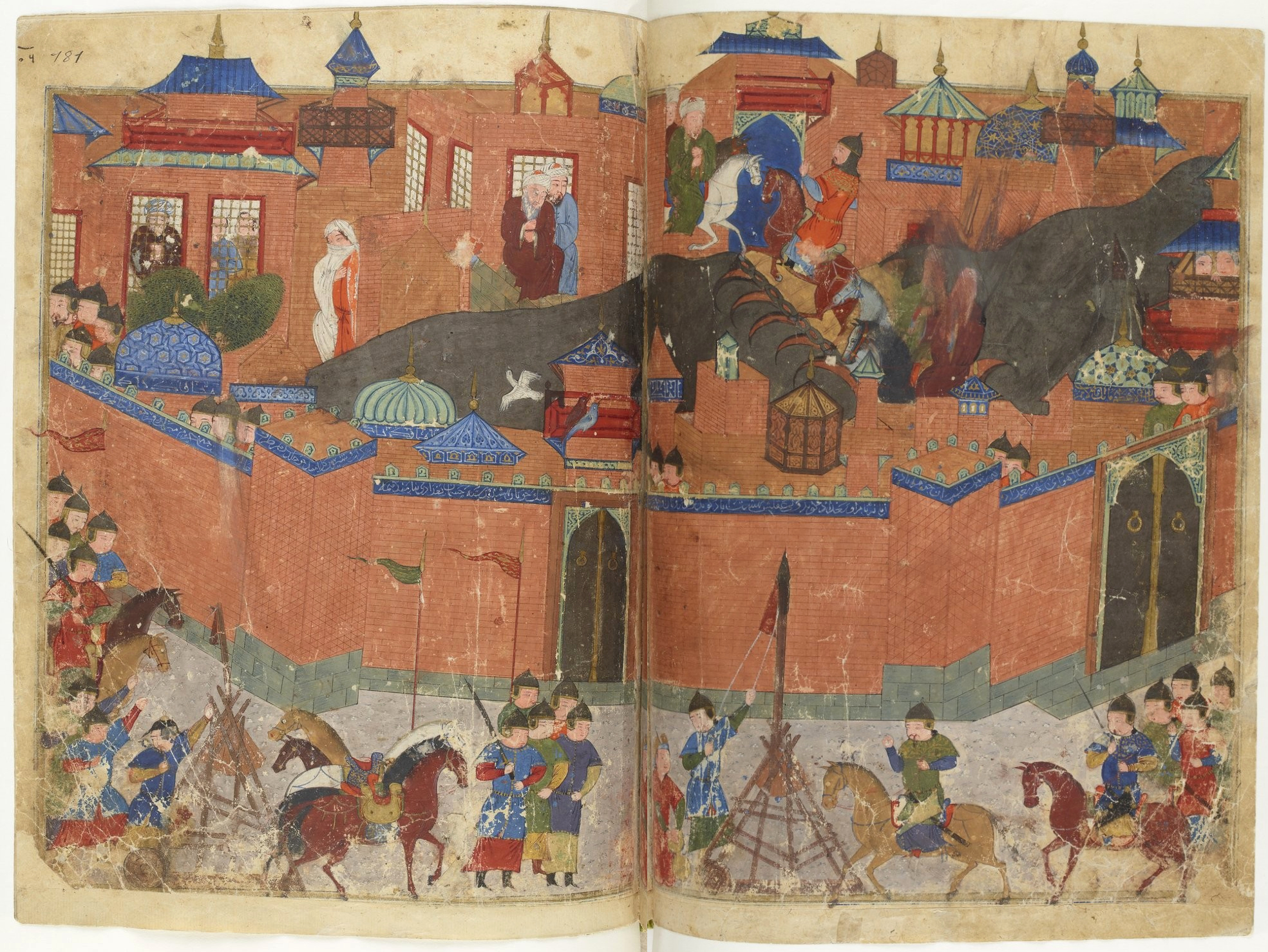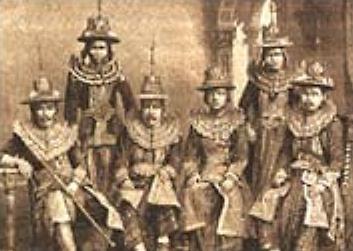|
First Mongol Invasions Of Burma
The first Mongol invasions of Burma ( Burmese: မွန်ဂို–မြန်မာ စစ် (၁၂၇၇–၁၂၈၇); Chinese: 元緬戰爭) were a series of military conflicts between Kublai Khan's Yuan dynasty, a division of the Mongol Empire, and the Pagan Empire that took place between 1277 and 1287. The invasions toppled the 250-year-old Pagan Empire, and the Mongol army seized Pagan territories in present-day Dehong, Yunnan and northern Burma to Tagaung. The invasions ushered in 250 years of political fragmentation in Burma and the rise of ethnic Tai-Shan states throughout mainland Southeast Asia. The Mongols first demanded tribute from Pagan in 1271–1272, as part of their drive to encircle the Song dynasty of China. When King Narathihapate refused, Emperor Kublai Khan himself sent another mission in 1273, again demanding tribute. It too was rejected. In 1275, the emperor ordered the Yunnan government to secure the borderlands in order to block an escap ... [...More Info...] [...Related Items...] OR: [Wikipedia] [Google] [Baidu] |
Mongol Invasions And Conquests
The Mongol invasions and conquests took place during the 13th and 14th centuries, creating history's largest contiguous empire, the Mongol Empire (1206–1368), which by 1260 covered large parts of Eurasia. Historians regard the destruction under the Mongol Empire, Mongol devastation as one of the deadliest episodes in history. At its height, the Mongol Empire included modern-day Mongolia, China, North Korea, South Korea, Myanmar, Iran, Iraq, Afghanistan, Pakistan, Kashmir, Kazakhstan, Tajikistan, Kyrgyzstan, Turkmenistan, Uzbekistan, Siberia, Georgia (country), Georgia, Armenia, Azerbaijan, Turkey, Belarus, Ukraine, Moldova, Romania, and most of European Russia. Overview The Mongol Empire developed in the course of the 13th century through a series of victorious campaigns throughout Eurasia. At its height, it stretched from the Pacific to Central Europe. It was later known as the largest contiguous land empire of all time. In contrast with later Thalassocracy, "empires of the ... [...More Info...] [...Related Items...] OR: [Wikipedia] [Google] [Baidu] |
Yazathingyan
Yazathingyan (, ; 1263 – 1312/13) was a co-founder of Myinsaing Kingdom in present-day Central Burma (Myanmar).Coedès 1968: 209 As a senior commander in the Royal Army of the Pagan Empire, he, along with his two brothers Athinkhaya and Thihathu, led Pagan's successful defense of central Burma against the Mongol invasions in 1287. Following the collapse of the Pagan Empire, the brothers became rivals of King Kyawswa of Pagan in central Burma, and overthrew him in December 1297, nine months after Kyawswa became a Mongol vassal. They successfully defended the second Mongol invasion (1300–01), and emerged the sole rulers of central Burma. Early life Yazathingyan was born 1263 to a prominent family in Myinsaing in Central Burma. His father Theinkha Bo was a younger brother of the '' sawbwa'' (chief) of Binnaka, and had fled to Myinsaing after a dispute with his brother in 1260. Traditional ( British colonial era) scholarship identifies his father as an ethnic Shan.Ph ... [...More Info...] [...Related Items...] OR: [Wikipedia] [Google] [Baidu] |
Mainland Southeast Asia
Mainland Southeast Asia (historically known as Indochina and the Indochinese Peninsula) is the continental portion of Southeast Asia. It lies east of the Indian subcontinent and south of Mainland China and is bordered by the Indian Ocean to the west and the Pacific Ocean to the east. It includes the countries of Cambodia, Laos, Myanmar, Singapore, Thailand and Vietnam as well as Peninsular Malaysia. The term ''Indochina'' (originally ''Indo-China'') was coined in the early nineteenth century, emphasizing the historical cultural influence of Indian and Chinese civilizations on the region. The term was later adopted as the name of the colony of French Indochina (present-day Cambodia, Laos, and Vietnam). Today, the term "Mainland Southeast Asia" is more commonly used, in contrast to Maritime Southeast Asia for the island groups off the coast of the peninsula. Terminology In Indian sources, the earliest name connected with Southeast Asia is . Another possible early name of mai ... [...More Info...] [...Related Items...] OR: [Wikipedia] [Google] [Baidu] |
Tai Peoples
Tai peoples are the populations who speak (or formerly spoke) the Tai languages. There are a total of about 93 million people of Tai ancestry worldwide, with the largest ethnic groups being Dai people, Dai, Thai people, Thai, Isan people, Isan, Tai Yai people, Tai Yai (Shan), Lao people, Lao, Ahom people, Tai Ahom, Tai Kassay and Northern Thai people, some Northern Thai peoples. The Tai are scattered through much of South China and Mainland Southeast Asia, with some (''e.g.'' Ahom people, Tai Ahom, Tai Kassay, Khamyang people, Tai Khamyang, Khamti people, Tai Khamti, Tai Phake people, Tai Phake, Tai Aiton) inhabiting parts of Northeast India. Tai peoples are both culturally and genetically very similar and therefore primarily identified through their language. Names Speakers of the many languages in the Tai branch of the Tai–Kadai languages, Tai–Kadai language family are spread over many countries in Southern China, Indochina and Northeast India. Unsurprisingly, there are ... [...More Info...] [...Related Items...] OR: [Wikipedia] [Google] [Baidu] |
History Of Burma
The history of Myanmar ( ) covers the period from the time of first-known human settlements 13,000 years ago to the present day. The earliest inhabitants of recorded history were a Tibeto-Burman-speaking people who established the Pyu city-states ranged as far south as Pyay and adopted Theravada Buddhism. Another group, the Bamar people, entered the upper Irrawaddy valley in the early 9th century. They went on to establish the Pagan Kingdom (1044–1297), the first-ever unification of the Irrawaddy valley and its periphery. The Burmese language and culture slowly came to replace Pyu norms during this period. After the First Mongol invasion of Burma in 1287, several small kingdoms, of which the Kingdom of Ava, the Hanthawaddy Kingdom, the Kingdom of Mrauk U and the Shan States were principal powers, came to dominate the landscape, replete with ever-shifting alliances and constant wars. From this time, the history of this region has been characterised by geopolitical strugg ... [...More Info...] [...Related Items...] OR: [Wikipedia] [Google] [Baidu] |
Chinese Language
Chinese ( or ) is a group of languages spoken natively by the ethnic Han Chinese majority and List of ethnic groups in China, many minority ethnic groups in China, as well as by various communities of the Chinese diaspora. Approximately 1.39 billion people, or 17% of the global population, speak a variety of Chinese as their first language. Chinese languages form the Sinitic languages, Sinitic branch of the Sino-Tibetan language family. The spoken varieties of Chinese are usually considered by native speakers to be dialects of a single language. However, their lack of mutual intelligibility means they are sometimes considered to be separate languages in a Language family, family. Investigation of the historical relationships among the varieties of Chinese is ongoing. Currently, most classifications posit 7 to 13 main regional groups based on phonetic developments from Middle Chinese, of which the most spoken by far is Mandarin Chinese, Mandarin with 66%, or around 800&nb ... [...More Info...] [...Related Items...] OR: [Wikipedia] [Google] [Baidu] |
Burmese Language
Burmese (; ) is a Tibeto-Burman languages, Tibeto-Burman language spoken in Myanmar, where it is the official language, lingua franca, and the native language of the Bamar people, Bamar, the country's largest ethnic group. Burmese dialects are also spoken by the indigenous tribes in Bangladesh's Chittagong Hill Tracts, India's Mizoram, Manipur, Tripura states and the Burmese diaspora. The Constitution of Myanmar officially refers to it as the Myanmar language in English, though most English speakers continue to refer to the language as ''Burmese'', after ''Burma''—a name with co-official status until 1989 (see Names of Myanmar). Burmese is the most widely-spoken language in the country, where it serves as the lingua franca. In 2019, Burmese was spoken by 42.9 million people globally, including by 32.9 million speakers as a first language, and an additional 10 million speakers as a second language. A 2023 World Bank survey found that 80% of the country's population speaks Burmese ... [...More Info...] [...Related Items...] OR: [Wikipedia] [Google] [Baidu] |
Royal Burmese Armed Forces
The Royal Armed Forces (,See (Maha Yazawin 2006: 26), (Yazawin Thit Vol. 1 2012: 236), (Hmannan Vol. 2 2012: 2) for example. ) were the armed forces of the History of Myanmar, Burmese monarchy from the 9th to 19th centuries. It refers to the military forces of the Pagan Kingdom, the Kingdom of Ava, the Hanthawaddy Kingdom, the Toungoo dynasty and the Konbaung dynasty in chronological order. The army was one of the major armed forces of Southeast Asia until it was defeated by the British Empire, British over a six-decade span in the 19th century. The army was organised into a small standing army of a few thousand, which defended the capital and the palace, and a much larger conscription, conscript-based wartime army. Conscription was based on the ''ahmudan'' system, which required local chiefs to supply their predetermined quota of men from their jurisdiction on the basis of population in times of war. The wartime army also consisted of war elephant, elephantry, cavalry, artill ... [...More Info...] [...Related Items...] OR: [Wikipedia] [Google] [Baidu] |
Mongols
Mongols are an East Asian ethnic group native to Mongolia, China ( Inner Mongolia and other 11 autonomous territories), as well as the republics of Buryatia and Kalmykia in Russia. The Mongols are the principal member of the large family of Mongolic peoples. The Oirats and the Buryats are classified either as distinct ethno-linguistic groups or as subgroups of Mongols. The Mongols are bound together by a common heritage and ethnic identity, descending from the Proto-Mongols. Their indigenous dialects are collectively known as the Mongolian language. The contiguous geographical area in which the Mongols primarily live is referred to as the Mongol heartland, especially in discussions of the Mongols' history under the Mongol Empire. Definition Broadly defined, the term includes the Mongols proper (also known as the Khalkha Mongols), Buryats, Oirats, the Kalmyks and the Southern Mongols. The latter comprises the Abaga Mongols, Abaganar, Aohans, Arkhorchin, Asud, ... [...More Info...] [...Related Items...] OR: [Wikipedia] [Google] [Baidu] |
Persian People
Persians ( ), or the Persian people (), are an Iranian peoples, Iranian ethnic group from West Asia that came from an earlier group called the Proto-Iranians, which likely split from the Indo-Iranians in 1800 BCE from either Afghanistan or Central Asia. They are indigenous to the Iranian plateau and comprise the majority of the population of Iran.Iran Census Results 2016 United Nations Alongside having a Culture of Iran, common cultural system, they are native speakers of the Persian language and of the Western Iranian languages that are closely related to it. In the Western world, "Persian" was largely understood as a demonym for all Iranians rather than as an ethnonym for the Persian people, but this understanding Name of Iran, shi ... [...More Info...] [...Related Items...] OR: [Wikipedia] [Google] [Baidu] |
Central Asia
Central Asia is a region of Asia consisting of Kazakhstan, Kyrgyzstan, Tajikistan, Turkmenistan, and Uzbekistan. The countries as a group are also colloquially referred to as the "-stans" as all have names ending with the Persian language, Persian suffix "-stan" (meaning ) in both respective native languages and most other languages. The region is bounded by the Caspian Sea to the southwest, European Russia to the northwest, China and Mongolia to the east, Afghanistan and Iran to the south, and Siberia to the north. Together, the five Central Asian countries have a total population of around million. In the pre-Islamic and early Islamic eras ( and earlier) Central Asia was inhabited predominantly by Iranian peoples, populated by Eastern Iranian-speaking Bactrians, Sogdians, Khwarezmian language, Chorasmians, and the semi-nomadic Scythians and Dahae. As the result of Turkic migration, Central Asia also became the homeland for the Kazakhs, Kyrgyzs, Volga Tatars, Tatars, Turkmens, ... [...More Info...] [...Related Items...] OR: [Wikipedia] [Google] [Baidu] |







